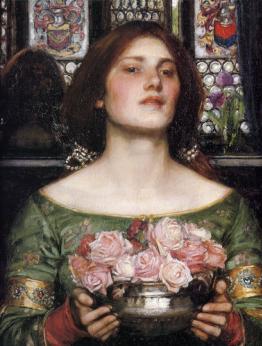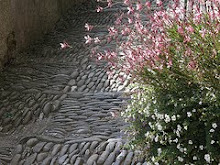THE HOUSE OF LIFE
SONNET IX
THE PORTRAIT
O Lord of all compassionate control,
O Love! let this my lady's picture glow
Under my hand to praise her name, and show
Even of her inner self the perfect whole:
That he who seeks her beauty's furthest goal,
Beyond the light that the sweet glances throw
And refluent wave of the sweet smile, may know
The very sky and sea-line of her soul.
Lo! it is done. Above the long lithe throat
The mouth's mould testifies of voice and kiss,
The shadowed eyes remember and foresee.
Her face is made her shrine. Let all men note
That in all years (O Love, thy gift is this!)
They that would look on her must come to me.
~~~~~~~~~~~~~~~~~~~~~~~~~~
SONNET IX
THE PORTRAIT
O Lord of all compassionate control,
O Love! let this my lady's picture glow
Under my hand to praise her name, and show
Even of her inner self the perfect whole:
That he who seeks her beauty's furthest goal,
Beyond the light that the sweet glances throw
And refluent wave of the sweet smile, may know
The very sky and sea-line of her soul.
Lo! it is done. Above the long lithe throat
The mouth's mould testifies of voice and kiss,
The shadowed eyes remember and foresee.
Her face is made her shrine. Let all men note
That in all years (O Love, thy gift is this!)
They that would look on her must come to me.
~~~~~~~~~~~~~~~~~~~~~~~~~~
"The sonnet is associated with three specific pictures by DGR and with three distinct women. No hard evidence connects the sonnet to the famous picture 'Beata Beatrix', the memorial reconstruction of DGR's wife as his visionary Beatrice, but this connection is commonly made. The portrait in colored chalks of Jane Morris, signed and dated by DGR 1869 and called '[A] Portrait', was exhibited in 1883 at the Royal Academy Exhibition. According to Ford Madox Brown, however, the sonnet “was written to accompany 'Mrs. Morris in a Blue Dress'" (see Newman and Watkinson, Ford Madox Brown, 155). Finally, Stephens says that the sonnet referred chiefly to Alexa Wilding ( Dante Gabriel Rossetti 173 ).."
http://www.rossettiarchive.org/docs/1-1868.s212.raw.html~~~~~~~~~~~~~~~~~~~~~~~~~~~


A Portrait, 1869
Even of her inner self the perfect whole,
The very sky and sea-line of her soul.
(Note: The above verses from Rossetti's sonnet, The Portrait
were "reportedly inscribed on the original frame.")
http://www.rossettiarchive.org/docs/s212.rap.html
The very sky and sea-line of her soul.
(Note: The above verses from Rossetti's sonnet, The Portrait
were "reportedly inscribed on the original frame.")
http://www.rossettiarchive.org/docs/s212.rap.html
_1868.jpg)
Mrs. William Morris (The Blue Silk Dress), 1868
Latin verse inscription that DGR composed for the painting:
'Famous for her poet husband, and most famous for her face,
finally let her be famous for my picture!' - Link
'Famous for her poet husband, and most famous for her face,
finally let her be famous for my picture!' - Link
"Though not technically a double work, the painting is connected to many of DGR's most central writings and pictures. The all but explicit connection to “The Portrait” is made via the Latin verse inscription that DGR composed for the painting. From that nexus a host of other relations proliferates, as the scholarly commentary shows. “The Portrait”, for example, has been the center of a long controversy about the specific painting to be associated with the sonnet so titled. But the truth is that DGR's whole aesthetic life was a pursuit of this ideal image of Beauty. Mrs. Morris came ultimately to represent for him perhaps the closest incarnation that he had ever known of that ideal form."
http://www.rossettiarchive.org/docs/s372.raw.html
Alexa Wilding, 1866
"So many differently inspired versions did Rossetti give us of the beauty of Alice Wilding. Nevertheless, I dare say, not a little of her charm existed mostly in the passionate heart of the painter; yet I well remember that nothing he drew of her, diverse as the delineations were, seemed less than an exact likeness. Of course, one saw her through the mood of the artist and it has sometimes appeared to me that the ardent sonnet he called 'The Portrait' referred, however generally, yet chiefly, to her, when he described how, when “my lady’s picture” was finished, he exclaimed –“Lo! it is done. Above the long, lithe throat The mouth’s mould testifies of voice and kiss, The shadowed eyes remember and foresee. Her face is made her shrine. Let all men note That in all years (O Love, thy gift is this!) They that would look on her must come to me.” - F. G. Stephens, Dante Gabriel Rossetti, 1899
[from the 2006 thesis by Jennifer J. Lee: Venus Imaginaria: Reflections on Alexa Wilding, Her Life, and Her Role as Muse in the Works of Dante Gabriel Rossetti - Link]
Alluring Alexa - an ArtMagick Art Album by stargazer
[from the 2006 thesis by Jennifer J. Lee: Venus Imaginaria: Reflections on Alexa Wilding, Her Life, and Her Role as Muse in the Works of Dante Gabriel Rossetti - Link]
Alluring Alexa - an ArtMagick Art Album by stargazer


























Excellent post, Cathy, thank you - just the kind of thing to add 'flesh to the bone,' so to speak, and to help in the interpretation of these wonderful works.
ReplyDeleteThanks so much for your comment, Robert. After coming across Rossetti's 1869 chalk work of Jane Morris I did some searching at the Rossetti Archive - the image seemed so different from his other ones with Jane (it seems the face has tones of Lizzie in it?). The searching led to this posting. Very glad you found it useful. Best wishes ...
ReplyDelete